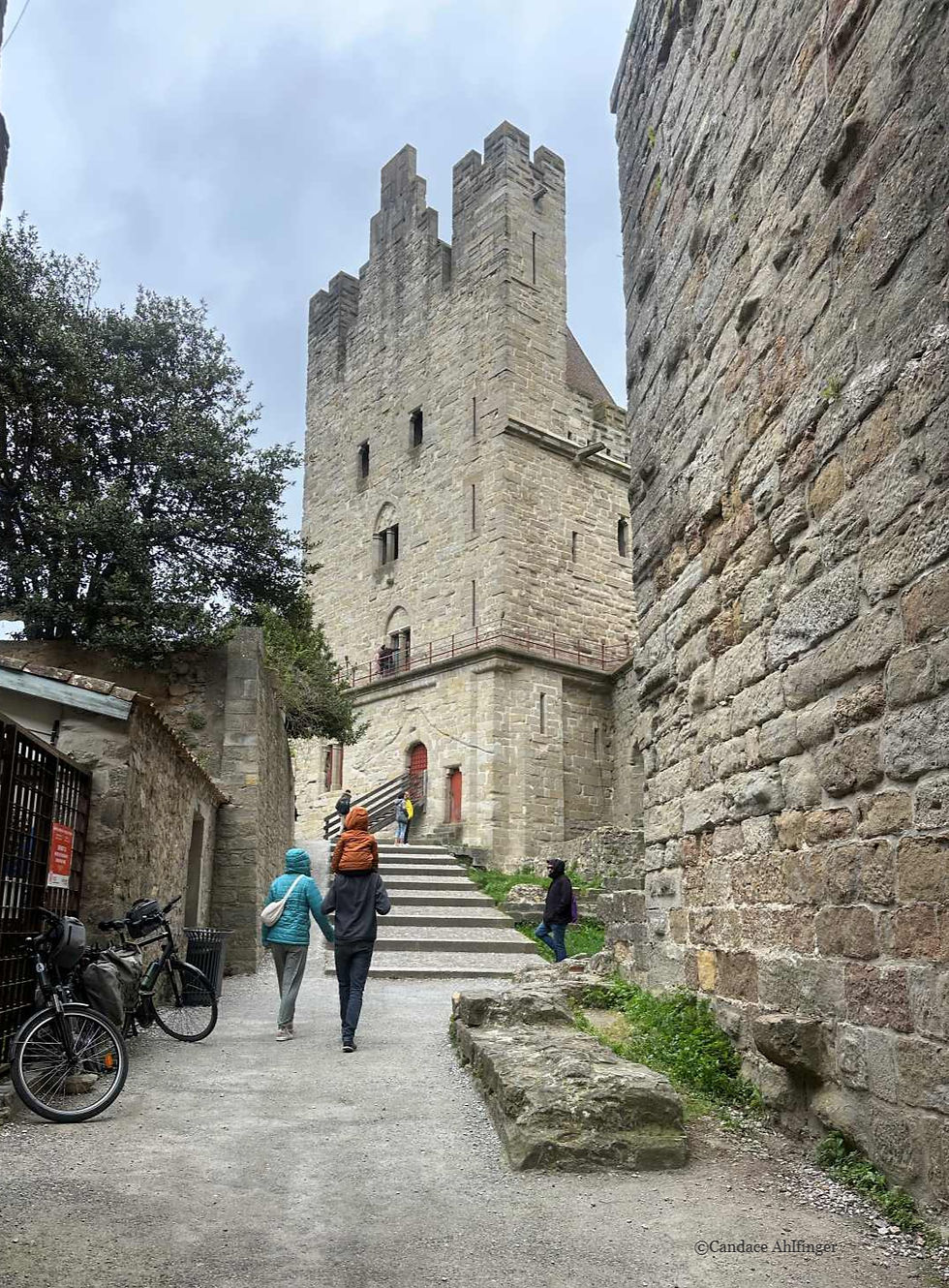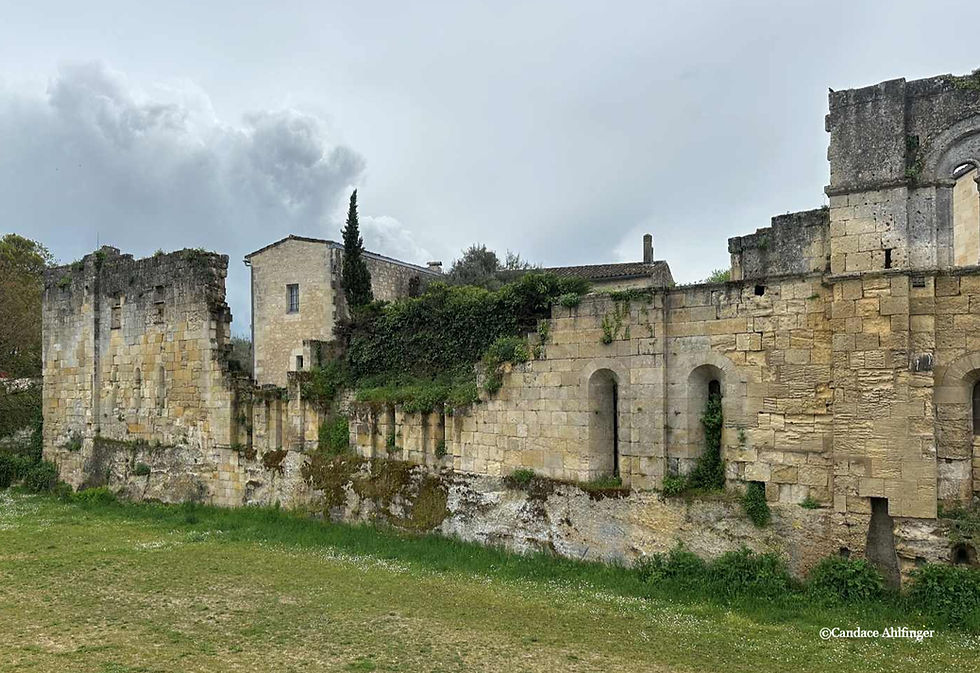48 Hours in Toulouse and Carcassonne, France
- Candace Ahlfinger
- Sep 9
- 6 min read

We traveled via train from Donostia/San Sebastian, Spain to Toulouse, France, which meant we took the commuter train from San Sebastian to Hendaye (You don’t need tickets ahead of time) where we switched trains--and adjacent buildings--for our ride from Hendaye to Toulouse (We had already bought these tickets.)
Toulouse, the fourth largest city in France, is also much less touristy than some other cities, but it is full of students which means that there is fun energy permeating it. The sun reflecting off the red brick buildings at sunset has resulted in the nickname of La Ville Rose, or the Pink City. (Bricks were used to build Toulouse because red clay was abundant whereas stones were not generally available in the area.)

Our hotel, Le Grand Balcon, reflected the amazing status of Toulouse as the center of the aerospace industry in France. For example, the picturesque bar is filled with statues and pictures of famous pilots. One of these was particularly of interest to us, Antoine de Saint-Exupéry, a famous pilot who is perhaps even more famous as the author of The Little Prince. The hotel is just off the Place du Capitole with our windows overlooking the square. We loved opening our windows to watch and hear everything going on below us, but we also appreciated the double windows that served to soundproof our room when needed.

Because our food tour of Toulouse was cancelled due to rain, we took advantage of the miniature tourist train that uses one of two routes. The English audio guide gave a good overview of what we were seeing. (The audio guide is available in English and several other languages. You simply have to block out the French that is being played over the speakers.) Our second idea, the Museo Augustine, was closed for renovation, but the tourist information center was very helpful in filling our suddenly empty day.

We had already sipped wine and had snacks at Le Florida on the Place du Capitole, but we had not gone into the magnificent Le Capitole government center. (Entrance is free and I would definitely recommend going in.) The Sale du Illustres, Hall of Paintings, on the second floor is amazingly beautiful. The massive paintings and sculptures by French artists were mouth dropping.

Toulouse is located in the Occitanie region of France. One character in many pieces of art in this region is the presence of troubadours who actually began in the 11th century in this area. Troubadours travelled around the Occitanie region entertaining the nobility with songs and poetry in the Occitanie language. (Did I mention that streets may have two name signs, one in French and one in Occitanie?) Even today, the heritage of troubadours survives with annual contests in the region. Occitanie history is evident in other ways including at the Place du Capitole where a large Occitan cross can be seen in the stone pavement.

After Le Capitole, we walked back down to the Pont Neuf Bridge over the Garonne River that we had seen on our mini-train tour. People of all ages and descriptions sat along the banks, picnicking, napping, and reading. Market had sprung up in squares, so our walk was not as fast as usual as we stopped to look at the countless wares. One surprise that we encountered was the College Pierre de Fermat with its beautiful blue doors.

Another was the Couvent des Jacobins, the mother church of the Dominican Order, which has been deconsecrated, but still houses the relics of Sir Thomas Aquinas who was a member of the order. (The Dominicans religious order was founded to fight the threat that the Catholic Church felt from the Cathars with more info about the Cathars later.) The church has been added on and changed in an intriguing manner and the stunning cloisters give a great respite on a hot day.

Another church of interest is the Basilica of Notre-Dame de la Daurade. Though the current basilica was built in the 19th century, its history dates back to 410 AD when the emperor decreed that pagan temples could be converted into Christian churches.

We enjoyed wandering the streets of Toulouse which are filled with shopping and restaurants. Every meal we had was delicious—from cassoulet at Emile, to pizza at Prima Lova, to steak at La Braisière.

We had planned three nights in Toulouse so we could visit nearby Carcassonne. We took the train and arrived at the La Cité, the preserved medieval walled city, in time for our pre-arranged tour. La Cité is an imposing site from its high point that overlooks the city and the surrounding countryside. It is the largest walled medieval fortress in Europe and a UNESCO World Heritage site. Romans, Visigoths, Franks, and French kings are just a few who have owned the land under the city and many of them restored and added to what had existed previously with the last expansion being in the 13th century by the French who added a second wall to further fortify the city. In fact, La Cité has never fallen to force—although it has fallen to siege.

One of the most interesting stories of La Cité is how it received its name. Legend has it that Charlemagne had laid siege to the city when Lord Carcas was absent. His wife, Lady Carcas, defended the city through several years until she was left with only one pig to feed all the soldiers and families within the walls. She ordered the pig be fed whatever food was left and then the pig was catapulted over the wall into the midst of Charlemagne’s forces. Charlemagne’s forces were amazed, believing that Lady Carcas still had so much food that she was feeding her pigs and throwing them over the wall. Thinking the task of overthrowing the city to be hopeless, Charlemagne called an end to the siege and his troops retreated. Legend has it that Lady Carcas rang the bells to celebrate the troops’ retreat. One of Charlemagne’s men announced that, “Carcas is ringing” which, in French, was “Carcas sonne.”

The 13th century was a dark time for Carcassonne. Pope Innocent III launched the first and last Inquisition in Europe, the Albigensian Crusade, against the Cathars, a religious group who believed that anything spiritual was good and physical was bad. The Catholic Church called them heretics and vowed to eliminate them in the first and only inquisition of Christians against Christians. The pope hired mercenaries who were willing to work for indulgences from the church instead of money. They were to round up and imprison all Cathars. Upon being given the option of denouncing their religion or being burned at the stake. Almost all Cathars chose to be burned at the stake, thus exterminating the Cathar followers and eliminating the religion.

The citadel area is filled with shops and restaurants catering to the millions of tourists that visit annually. A five-star hotel tops the mountain along with the Basilique Saint-Sernin that demonstrates is one of the largest examples of Romanesque architecture and is a stop on the Camino de Santiago pilgrimage. The basilica is flooded with light through the many beautiful stained-glass windows. These windows not only provided light to the illiterate peasants who, themselves, lived in dark hovels, but also told the Bible stories through the pictures.
The castle grounds are free to visit, but you can pay a small fee to walk the ramparts and visit the museum.

We enjoyed our short time in Carcassonne before wandering back down the steep hill, over the Canal de Midi, built from 1667 and 1694 as a shortcut for shipping between the Atlantic Ocean and the Mediterranean Sea, and then back to the train station and Toulouse for one more night before heading to Andorra, the small country nestled high in the Pyrenees Mountains between France and Spain.

More info on food: We ate at Le Florida for an excellent salad lunch while on the Capitole Square. Emile's cassoulet is famous--and wonderful. The dish is very filling. La Braisière served an excellent steak. (Make reservations at both Emile's and La Braisière.) We had pizza one night--every trip seems to have one night that we just have to eat pizza--at Prima Lova which was packed. We got there a few minutes before it opened at 7:00 to find a line. The truffle pizza was fantastic. (The line moved quickly.) All of these restaurants are "do-agains" if we are in the area.
For more info on our France, Spain, and Andorra trip click the links below:
Please subscribe to my blog to follow us on our adventures. Just click here and leave your email address.








Comments